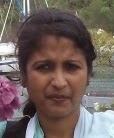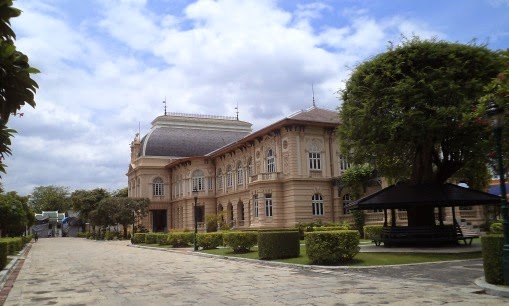Our next door global destination
Bangkok
The “City of Angels” on the banks of river Chao Phraya, also known as “King of Rivers” stretches over 1,500 sq. km, is the glitzy city that is a shopper’s sanctuary and a traveller’s world with a plethora of glittering shopping malls, ancient shrines and a vibrant night life.
This
destination always features on my Bangkok tour itinerary.
Around 50 km from Bangkok is the Central Province of Ratchaburi that is a traveller’s delight for its Damnoen Saduak Floating Market.
Around 62 km from Hua Hin is Phetchaburi that implies the “City of Diamonds” in Thai.
Ayuthayya
During my first visit to Thailand in April 2011, I travelled to Ayuthayya to experience the fun of Songkran celebration. Once the capital of Siam, Ayuthayya or Phra Nakhon Si
Ayuthayya
was the brainchild of former Thai king, U-Thong in 1767 and there are
abundant architectural grandeurs in the historic city.
The
most outstanding monastery in Ayuthayya is Wat Phra Si Sanphet that
was once a residential palace and is much similar to Wat Pho in
Bangkok. An outer view of Wihan Phra Mongkhon Bophit
It
was in July, 2014 that I was invited by Tourism Authority of Thailand
to participate in Thailand Happiness Street Festival held at Bangkok
Convention Centre and Centara Grand at Central World in Ratchaprasong
area of Bangkok.
The “City of Angels” on the banks of river Chao Phraya, also known as “King of Rivers” stretches over 1,500 sq. km, is the glitzy city that is a shopper’s sanctuary and a traveller’s world with a plethora of glittering shopping malls, ancient shrines and a vibrant night life.
Grand
Palace and Wat Phra Kaeo
No visit to
Bangkok is complete without a peek into the spectacular Grand Palace
done up with gold leaf and attractive tiling with polished Italian
marbles on the walls.
At the entrance, there is a chedi or a huge
pagoda that has the ashes of Lord Buddha brought from India.
Wat Phra
Kaeo or the shrine of Emerald Buddha is a magnificent shrine
reflecting Thai art that houses the statue of Buddha in jade.
The
walls at the entrance have the mural paintings illustrating Ramayana.
We sighted the replica of Angkor Vat temple of Cambodia at the Grand
Palace.
There is Boroma Piman or Royal Guest House at Grand Palace.
Wat
Pho
The
400-year-old shrine of Reclining Buddha lying close to Grand Palace
and is the largest shrine in the city. A moment of divine bliss when
one gets a chance to view the image of reclining Buddha from up-close
quarters. Again, this was my second visit to Wat Pho.
The gold-plated
image was constructed in 1832 spanning 46-metre long and 15-metre
high and evokes the thought of Lord Buddha’s entry into Nirvana.
Wat
Arun
Also
famed as the shrine of Dawn on the Thonburi side opposite Grand
Palace and belongs to the Ayuthayya period. Siam Ocean World Opened
in 2005, it is the largest aquarium in South-East Asia and a great
attraction for visitors.
Siam
Niramit
The
centre provides mind-boggling performances of Thailand’s art and
cultural heritage by 150 performers using 500 costumes.
We also had a
look at the ancient Thai hamlets that have been recreated at the
centre exhibiting the art of making rice pudding, garland making,
Thai craft and making Thai silk and playing Thai folk music.
Ratchaburi
Around 50 km from Bangkok is the Central Province of Ratchaburi that is a traveller’s delight for its Damnoen Saduak Floating Market.
We took
a tail speed long boat along the canal to get sound views of the
floating market that depicts the traditional lifestyle of rural folks
on river banks. There are miniature shops lined on either side of
floating market and speed boats and paddle boats selling everything
from lip-smacking Thai food to exquisite hand crafted art curious and
pottery works, masks to Thai umbrellas.
On
the way to Ratchaburi is the Meyklong Adventure Market on the tracks
of Meyklong railway station. An interesting feature of the market is
the traders along with their goods shift to the nearby place when any train passes on the
railway tracks.
Hua
Hin
A
fishing hamlet in 19th century, Hua Hin in Prachuapkhiri Khan
Province in the Gulf off Thailand is 200 km south of Bangkok. It has
one of the oldest beaches in Thailand. It is well-known as a summer
palace of the royal dynasty of Thailand and king Rama VII discovered
the palace in 1920.
Hua Hin Railway Station is the most prominent
landmark of the beach resort, notably one of the oldest stations in
Thailand that came up during the reign of king Rama VI.
 |
| Mongkut Klao Pavilion |
The special
feature of the station is the Mongkut Klao Pavilion built to greet
the king.
For those who have adventure in their
blood, a visit to Phraya Nakhon cave snuggled atop the hill of Khao
Sam Roi Yot National Park is a must.
It is a sheltered gulf in the
Gulf of Thailand that was discovered around 200 years ago by a former
ruler of Thailand who had sought shelter in the cave to escape from a
storm.
Lying in Pranburi which is 45 km from Hua Hin, we embarked
upon the arduous trek to reach the cave lying at 450 metres high. The
sky was overcast and it was drizzling when we began our uphill climb
through boulders, rocks and tree branches in the midst of pristine
wilderness. At places, I had to crawl over rocks.
Upon reaching the
cave, we sighted a huge limestone cave made of three caverns, two of
which have skylights that are virtual sinkholes.
The cave looks fascinating with a number of trees taking roof in the caverns. The trekking terrain in the cave was quite dark and we had to cross a wooden bridge.
The cave looks fascinating with a number of trees taking roof in the caverns. The trekking terrain in the cave was quite dark and we had to cross a wooden bridge.
The
middle of the cave has a Tetrahedron Pavilion on a mound that was
laid down by king Rama V during Buddhist Era 2433. The pavilion
represents the symbol of Prachuapkhiri Province and was done by
skilled workers in Bangkok and taken to the existing site.
The trekking expedition was a life-changing experience for me.
Phetchaburi
Around 62 km from Hua Hin is Phetchaburi that implies the “City of Diamonds” in Thai.
The premier attraction is Phra Nakhon Khiri
Palace that denotes holy city hill is the premier palace on a
mountain range in Thailand.
We took the cable car ride to reach the
palace lying in the historical park around 95 metres high above the
sea level. We had to negotiate through a flight of steps and cobbled
paths that lead to the palace. Locally famed as “Khao Wang” or
the mountain with a palace, it flaunts a fusion of European, Chinese
and Thai art.
Set up in 1858 by king Rama IV or king Mongkut, the
palace is spread over three peaks-western, central and eastern. We
glanced at king Mongkut’s Palace at western peak that houses the
king’s residential quarters.
There is Wat Phra Kaew- the shrine
devoted to the king. Travellers visiting the palace need to take care
since there are scores of monkeys in the park.
Ayuthayya
During my first visit to Thailand in April 2011, I travelled to Ayuthayya to experience the fun of Songkran celebration. Once the capital of Siam, Ayuthayya or Phra Nakhon Si
A glimpse of Wat Phra Si Sanphet
Ayuthayya is 76 km from Bangkok and has
been declared as a World Heritage Site by UNESCO in 1991. The fabled
city derived its name from Ayodhya, remained the capital for 417
years and flourished during 17th century. The city was under
different royal dynasties of Thailand and was plundered by Burmese in
1767.
We visited
Wihan Phra Mongkhon Bophit – a huge sanctuary honouring tall,
century-old, bronze image of Buddha that was installed during the
rule of Thai king Songtham.
It is incidentally one of the largest
images of Buddha in bronze. A popular belief goes on in Thai that the
Lord fulfills the wishes of devotees on Songkran.
An outer view of Wihan Phra Mongkhon Bophit
We had wonderful glimpses of the three towering chedis or
pyramid-style stupas that are artistically inclined and are the prime
attractions of Ayuthayya. A chedi has a Burmese architecture at its
base and its upper tiers depict Thai style of art. During the golden
period of Ayuthayya, Wat Phra Si Sanphet earned glory across Asia for
its architectural wonder.












































